Landslide Identification and Gradation Method Based on Statistical Analysis and Spatial Cluster Analysis
Abstract
:1. Introduction
- SBAS-InSAR and stacking-InSAR are combined to generate deformation maps in the study area, which can obtain more information to avoid the omission of landslides in the study area;
- Statistical analysis and spatial cluster analysis are used to extract deformation regions and landslide polygons, which can provide a unified benchmark for landslide identification in different regions;
- A landslides screening model (LSM) based on multivariate features is proposed to screen landslide polygons, which can reduce the interference of noise in landslide identification; and
- A landslides gradation model (LGM) based on the signum function is proposed to divide screened landslides into four risk grades for geological disaster monitoring and risk assessment to provide effective information.
2. Methods
2.1. InSAR Processing and Deformation Results Acquisition
- D-InSAR processing.
- 2.
- SBAS-InSAR processing.
- 3.
- Stacking-InSAR processing.
2.2. Deformation Region Extraction and Spatial Cluster Analysis
2.3. Landslide Screening Based on LSM
2.4. Landslide Gradation Based on LGM
3. Study Area and Datasets
3.1. Study Area
3.2. Datasets
4. Results and Analysis
4.1. Deformation Results
4.2. Landslides Identification and Gradation
4.3. Validation of Landslide Identification Results
5. Discussion
6. Conclusions
Author Contributions
Funding
Data Availability Statement
Acknowledgments
Conflicts of Interest
References
- Lewkowicz, A.G.; Way, R.G. Extremes of summer climate trigger thousands of thermokarst landslides in a High Arctic environment. Nat. Commun. 2019, 10, 1329. [Google Scholar] [CrossRef] [PubMed]
- Guthrie, R.H. The effects of logging on frequency and distribution of landslides in three watersheds on Vancouver Island, British Columbia. Geomorphology 2002, 43, 273–292. [Google Scholar] [CrossRef]
- Achache, J. Applicability of SAR Interferometry for operational monitoring of landslides. In Proceedings of the Second Ers Applications Workshop, London, UK, 6–8 December 1995. [Google Scholar]
- Dabbiru, L.; Aanstoos, J.V.; Hasan, K.; Younan, N.H.; Wei, L. Landslide detection on earthen levees with X-band and L-band radar data. In Proceedings of the Applied Imagery Pattern Recognition Workshop, Washington, DC, USA, 23–25 October 2013. [Google Scholar]
- Zhao, C.; Liu, X.; Zhang, Q.; Peng, J.; Xu, Q. Research on Loess Landslide Identification, Monitoring and Failure Mode with InSAR Technique in Heifangtai, Gansu. Geomat. Inf. Sci. Wuhan Univ. 2019, 44, 996–1007. [Google Scholar]
- Ferretti, A.; Prati, C. Nonlinear subsidence rate estimation using permanent scatterers in differential SAR interferometry. IEEE Trans. Geosci. Remote Sens. 2000, 38, 2202–2212. [Google Scholar] [CrossRef]
- Ferretti, A.; Prati, C.; Rocca, F. Permanent scatterers in SAR interferometry. IEEE Trans. Geosci. Remote Sens. 2001, 39, 8–20. [Google Scholar] [CrossRef]
- Ferretti, A.; Fumagalli, A.; Novali, F.; Prati, C.; Rucci, A. A New Algorithm for Processing Interferometric Data-Stacks: SqueeSAR. IEEE Trans. Geosci. Remote Sens. 2011, 49, 3460–3470. [Google Scholar] [CrossRef]
- Berardino, P.; Fornaro, G.; Lanari, R.; Sansosti, E. A New Algorithm for Surface Deformation Monitoring Based on Small Baseline Differential SAR Interferograms. IEEE Trans. Geosci. Remote Sens. 2002, 40, 2375–2383. [Google Scholar] [CrossRef]
- Lanari, R.; Mora, O.; Manunta, M.; Mallorquí, J.J.; Sansosti, E. A small-baseline approach for investigating deformations on full-resolution differential SAR interferograms. IEEE Trans. Geosci. Remote Sens. 2004, 42, 1377–1386. [Google Scholar] [CrossRef]
- Hooper, A. A new method for measuring deformation on volcanoes and other natural terrains using InSAR persistent scatterers. Geophys. Res. Lett. 2004, 31, L23611. [Google Scholar] [CrossRef]
- Sandwell, D.T.; Price, E.J. Phase gradient approach to stacking interferograms. J. Geophys. Res. Solid Earth 1998, 103, 30183–30204. [Google Scholar] [CrossRef]
- Zebker, H.A.; Villasenor, J. Decorrelation in interferometric radar echoes. IEEE Trans. Geosci. Remote Sens. 1992, 30, 950–959. [Google Scholar] [CrossRef] [Green Version]
- Hanssen, R.F. Radar Interferometry; Springer: Berlin/Heidelberg, Germany, 2001. [Google Scholar]
- Goldstein, R. Atmospheric limitations to repeat-track radar interferometry. Geophys. Res. Lett. 2013, 22, 2517–2520. [Google Scholar]
- Pepe, A.; Berardino, P.; Bonano, M.; Euillades, L.D.; Lanari, R. SBAS-Based Satellite Orbit Correction for the Generation of DInSAR Time-Series: Application to RADARSAT-1 Data. IEEE Trans. Geosci. Remote Sens. 2011, 49, 5150–5165. [Google Scholar] [CrossRef]
- Gabriel, A.K.; Goldstein, R.M.; Zebker, H.A. Mapping small elevation changes over large areas: Differential radar interferometry. J. Geophys. Res. Solid Earth 1989, 94, 9183–9191. [Google Scholar] [CrossRef]
- Liu, X.; Zhao, C.; Zhang, Q.; Yin, Y.; Lu, Z.; Samsonov, S.; Yang, C.; Wang, M.; Tomas, R. Three-dimensional and long-term landslide displacement estimation by fusing C- and L-band SAR observations: A case study in Gongjue County, Tibet, China. Remote Sens. Environ. 2021, 267, 112745. [Google Scholar] [CrossRef]
- Burrows, K.; Walters, R.J.; Milledge, D.; Spaans, K.; Densmore, A.L. A New Method for Large-Scale Landslide Classification from Satellite Radar. Remote Sens. 2019, 11, 237. [Google Scholar] [CrossRef]
- Hu, X.; Wang, T.; Pierson, T.C.; Lu, Z.; Kim, J.; Cecere, T.H. Detecting seasonal landslide movement within the Cascade landslide complex (Washington) using time-series SAR imagery. Remote Sens. Environ. 2016, 187, 49–61. [Google Scholar] [CrossRef]
- Chen, L.; Zhao, C.; Kang, Y.; Chen, H.; Yang, C.; Li, B.; Liu, Y.; Xing, A. Pre-Event Deformation and Failure Mechanism Analysis of the Pusa Landslide, China with Multi-Sensor SAR Imagery. Remote Sens. 2020, 12, 856. [Google Scholar] [CrossRef]
- Wang, J.; Wang, C.; Xie, C.; Zhang, H.; Tang, Y.; Zhang, Z.; Shen, C. Monitoring of large-scale landslides in Zongling, Guizhou, China, with improved distributed scatterer interferometric SAR time series methods. Landslides 2020, 17, 1777–1795. [Google Scholar] [CrossRef]
- Tang, Y.; Zhang, Z.; Wang, C.; Zhang, H.; Wu, F.; Liu, M. Characterization of the giant landslide at Wenjiagou by the insar technique using TSX-TDX CoSSC data. Landslides 2015, 12, 1015–1021. [Google Scholar] [CrossRef]
- Tang, Y.; Zhang, Z.; Wang, C.; Zhang, H.; Wu, F.; Zhang, B.; Liu, M. The deformation analysis of Wenjiagou giant landslide by the distributed scatterer interferometry technique. Landslides 2018, 15, 347–357. [Google Scholar] [CrossRef]
- Hilley, G.E.; Burgmann, R.; Ferretti, A.; Novali, F.; Rocca, F. Dynamics of slow-moving landslides from permanent scatterer analysis. Science 2004, 304, 1952–1955. [Google Scholar] [CrossRef] [PubMed] [Green Version]
- Zhao, C.; Lu, Z.; Zhang, Q.; de la Fuente, J. Large-area landslide detection and monitoring with ALOS/PALSAR imagery data over Northern California and Southern Oregon, USA. Remote Sens. Environ. 2012, 124, 348–359. [Google Scholar] [CrossRef]
- Xiao-jun, S.; Yi, Z.; Xing-min, M.; Dong-xia, Y.; Jin-hui, M.; Fu-yun, G.; Zi-qiang, Z.; Rehman, M.U.; Khalid, Z.; Guan, C.; et al. Landslide mapping and analysis along the China-Pakistan Karakoram Highway based on SBAS-InSAR detection in 2017. J. Mt. Sci.-Engl. 2021, 18, 2540–2564. [Google Scholar]
- Tofani, V.; Raspini, F.; Catani, F.; Casagli, N. Persistent Scatterer Interferometry (PSI) Technique for Landslide Characterization and Monitoring. Remote Sens. 2013, 5, 1045–1065. [Google Scholar] [CrossRef]
- Ren, T.; Gong, W.; Gao, L.; Zhao, F.; Cheng, Z. An Interpretation Approach of Ascending-Descending SAR Data for Landslide Identification. Remote Sens. 2022, 14, 1299. [Google Scholar] [CrossRef]
- Qu, T.; Lu, P.; Liu, C.; Wan, H. Application of Time Series Insar Technique for Deformation Monitoring of Large-Scale Landslides in Mountainous Areas of Western China. Int. Arch. Photogramm. Remote Sens. Spat. Inf. Sci. 2016, 41, 89–91. [Google Scholar] [CrossRef]
- Bozzano, F.; Mazzanti, P.; Esposito, C.; Moretto, S.; Rocca, A. Potential of satellite InSAR monitoring for landslide Failure Forecasting. In Landslides and Engineered Slopes. Experience, Theory and Practice; CRC Press: Boca Raton, FL, USA, 2016; pp. 523–530. [Google Scholar]
- Jin, J.; Chen, G.; Meng, X.; Zhang, Y.; Shi, W.; Li, Y.; Yang, Y.; Jiang, W. Prediction of river damming susceptibility by landslides based on a logistic regression model and InSAR techniques: A case study of the Bailong River Basin, China. Eng. Geol. 2022, 299, 106562. [Google Scholar] [CrossRef]
- Moretto, S.; Bozzano, F.; Mazzanti, P. The Role of Satellite InSAR for Landslide Forecasting: Limitations and Openings. Remote Sens. 2021, 13, 3735. [Google Scholar] [CrossRef]
- Nof, R.N.; Baer, G.; Eyal, Y.; Novali, F. Current surface displacement along the carmel Fault system in Israel from InSAR stacking and PSInSAR. Isr. J. Earth Sci. 2008, 57, 71–86. [Google Scholar] [CrossRef]
- Wright, T.; Parsons, B.; Fielding, E. Measurement of interseismic strain accumulation across the North Anatolian Fault by satellite radar interferometry. Geophys. Res. Lett. 2001, 28, 2117–2120. [Google Scholar] [CrossRef]
- Zhang, L.; Dai, K.; Deng, J.; Ge, D.; Liang, R.; Li, W.; Xu, Q. Identifying Potential Landslides by Stacking-InSAR in Southwestern China and Its Performance Comparison with SBAS-InSAR. Remote Sens. 2021, 13, 3662. [Google Scholar] [CrossRef]
- Jia, H.; Wang, Y.; Ge, D.; Deng, Y.; Wang, R. InSAR Study of Landslides: Early Detection, Three-Dimensional, and Long-Term Surface Displacement Estimation—A Case of Xiaojiang River Basin, China. Remote Sens. 2022, 14, 1759. [Google Scholar] [CrossRef]
- Liu, X.; Zhao, C.; Zhang, Q.; Lu, Z.; Liu, C. Integration of Sentinel-1 and ALOS/PALSAR-2 SAR datasets for mapping active landslides along the Jinsha River corridor, China. Eng. Geol. 2021, 284, 106033. [Google Scholar] [CrossRef]
- Zhang, J.; Zhu, W.; Cheng, Y.; Li, Z. Landslide Detection in the Linzhi–Ya’an Section along the Sichuan–Tibet Railway Based on InSAR and Hot Spot Analysis Methods. Remote Sens. 2021, 13, 3566. [Google Scholar] [CrossRef]
- Anna, B.; Lorenzo, S.; Marta, B.; Oriol, M.; Silvia, B.; Gerardo, H.; Michele, C.; Roberto, S.; Elena, G.; Rosa, M. A Methodology to Detect and Update Active Deformation Areas Based on Sentinel-1 SAR Images. Remote Sens. 2017, 9, 1002. [Google Scholar]
- Aslan, G.; Foumelis, M.; Raucoules, D.; De Michele, M.; Bernardie, S.; Cakir, Z. Landslide Mapping and Monitoring Using Persistent Scatterer Interferometry (PSI) Technique in the French Alps. Remote Sens. 2020, 12, 1305. [Google Scholar] [CrossRef]
- Navarro, J.; Tomás, R.; Barra, A.; Pagán, J.I.; Crosetto, M. ADAtools: Automatic Detection and Classification of Active Deformation Areas from PSI Displacement Maps. Int. J. Geo-Inf. 2020, 9, 584. [Google Scholar] [CrossRef]
- Crippa, C.; Valbuzzi, E.; Frattini, P.; Crosta, G.B.; Spreafico, M.C.; Agliardi, F. Semi-automated regional classification of the style of activity of slow rock-slope deformations using PS InSAR and SqueeSAR velocity data. Landslides 2021, 18, 2445–2463. [Google Scholar] [CrossRef]
- Tomás, R.; Pagán, J.I.; Navarro, J.A.; Cano, M.; Casagli, N. Semi-Automatic Identification and Pre-Screening of Geological-Geotechnical Deformational Processes Using Persistent Scatterer Interferometry Datasets. Remote Sens. 2019, 11, 1675. [Google Scholar] [CrossRef]
- Wang, S.; Zhuang, J.; Mu, J.; Zheng, J.; Zhan, J.; Wang, J.; Fu, Y. Evaluation of landslide susceptibility of the Ya’an-Linzhi section of the Sichuan-Tibet Railway based on deep learning. Environ. Earth Sci. 2022, 81, 250. [Google Scholar] [CrossRef]
- Meghanadh, D.; Maurya, V.K.; Tiwari, A.; Dwivedi, R. A multi-criteria landslide susceptibility mapping using deep multi-layer perceptron network: A case study of Srinagar-Rudraprayag region (India). Adv. Space Res. 2022, 69, 1883–1893. [Google Scholar] [CrossRef]
- Getis, A.; Ord, J.K. The Analysis of Spatial Association by Use of Distance Statistics. Geogr. Anal. 1992, 24, 127–145. [Google Scholar] [CrossRef]
- Ping, L.U.; Casagli, N.; Catani, F.; Tofani, V. Persistent Scatterers Interferometry Hotspot and Cluster Analysis (PSI-HCA) for detection of extremely slow-moving landslides. Int. J. Remote Sens. 2012, 33, 466–489. [Google Scholar]
- Sandwell, D.; Mellors, R.; Tong, X.; Wei, M.; Wessel, P. Open radar interferometry software for mapping surface Deformation. EOS Trans. Am. Geophys. Union 2013, 92, 234. [Google Scholar] [CrossRef] [Green Version]
- Chen, C.W.; Zebker, H.A. Two-dimensional phase unwrapping with use of statistical models for cost functions in nonlinear optimization. J. Opt. Soc. Am. A 2001, 18, 338–351. [Google Scholar] [CrossRef]
- Chen, C.W.; Zebker, H.A. Phase Unwrapping for Large SAR Interferograms: Statistical Segmentation and Generalized Network Models. IEEE Trans. Geosci. Remote Sens. 2002, 40, 1709–1719. [Google Scholar] [CrossRef]
- Farr, T.G.; Rosen, P.A.; Caro, E.; Crippen, R.; Duren, R.; Hensley, S.; Kobrick, M.; Paller, M.; Rodriguez, E.; Roth, L.; et al. The shuttle radar topography mission. Rev. Geophys. 2007, 45, RG2004. [Google Scholar] [CrossRef]
- Liu, Z.; Qiu, H.; Zhu, Y.; Liu, Y.; Yang, D.; Ma, S.; Zhang, J.; Wang, Y.; Wang, L.; Tang, B. Efficient Identification and Monitoring of Landslides by Time-Series InSAR Combining Single- and Multi-Look Phases. Remote Sens. 2022, 14, 1026. [Google Scholar] [CrossRef]
- Ord, J.K.; Getis, A. Local Spatial Autocorrelation Statistics: Distributional Issues and an Application. Geogr. Anal. 1995, 27, 286–306. [Google Scholar] [CrossRef]
- Rosen, P.A.; Hensley, S.; Joughin, I.R.; Li, F.K.; Madsen, S.N.; Rodriguez, E.; Goldstein, R.M. Synthetic aperture radar interferometry—Invited paper. Proc. IEEE 2000, 88, 333–382. [Google Scholar] [CrossRef]
- Li, Y.; Meng, H.; Dong, Y.; Hu, S. Main Types and characterisitics of geo-hazard in China—Based on the results of geo-hazard survey in 290 counties. Chin. J. Geol. Hazard Control 2004, 15, 32–37. [Google Scholar]
- Wang, C.; Zhu, M.; Ma, Z.; He, Z.; Jiang, H.; Li, P.; Zhang, X.; Shi, J.; Chen, K.; Weng, T.; et al. Classification of Landslide Stability Based on Fine Topographic Features. In Proceedings of the 2020 17th International Computer Conference on Wavelet Active Media Technology and Information Processing (ICCWAMTIP), Chengdu, China, 18–20 December 2020; pp. 54–57. [Google Scholar]
- Wang, K.; Xu, H.; Zhang, S.; Wei, F.; Xie, W. Identification and Extraction of Geomorphological Features of Landslides Using Slope Units for Landslide Analysis. ISPRS Int. J. Geo-Inf. 2020, 9, 274. [Google Scholar] [CrossRef]
- Pawluszek, K. Landslide features identification and morphology investigation using high-resolution DEM derivatives. Nat. Hazards. 2019, 96, 311–330. [Google Scholar] [CrossRef]
- Doshida, S. The Difference in the Landslide Information by the Difference Between Geographical Features and Geological Conditions. In Advancing Culture of Living with Landslides; Mikos, M., Tiwari, B., Yin, Y., Sassa, K., Eds.; Springer International Publishing: Cham, Switzerland, 2017; pp. 999–1005. [Google Scholar]
- Luo, S.; Feng, G.; Xiong, Z.; Wang, H.; Zhao, Y.; Li, K.; Deng, K.; Wang, Y. An Improved Method for Automatic Identification and Assessment of Potential Geohazards Based on MT-InSAR Measurements. Remote Sens. 2021, 13, 3490. [Google Scholar] [CrossRef]
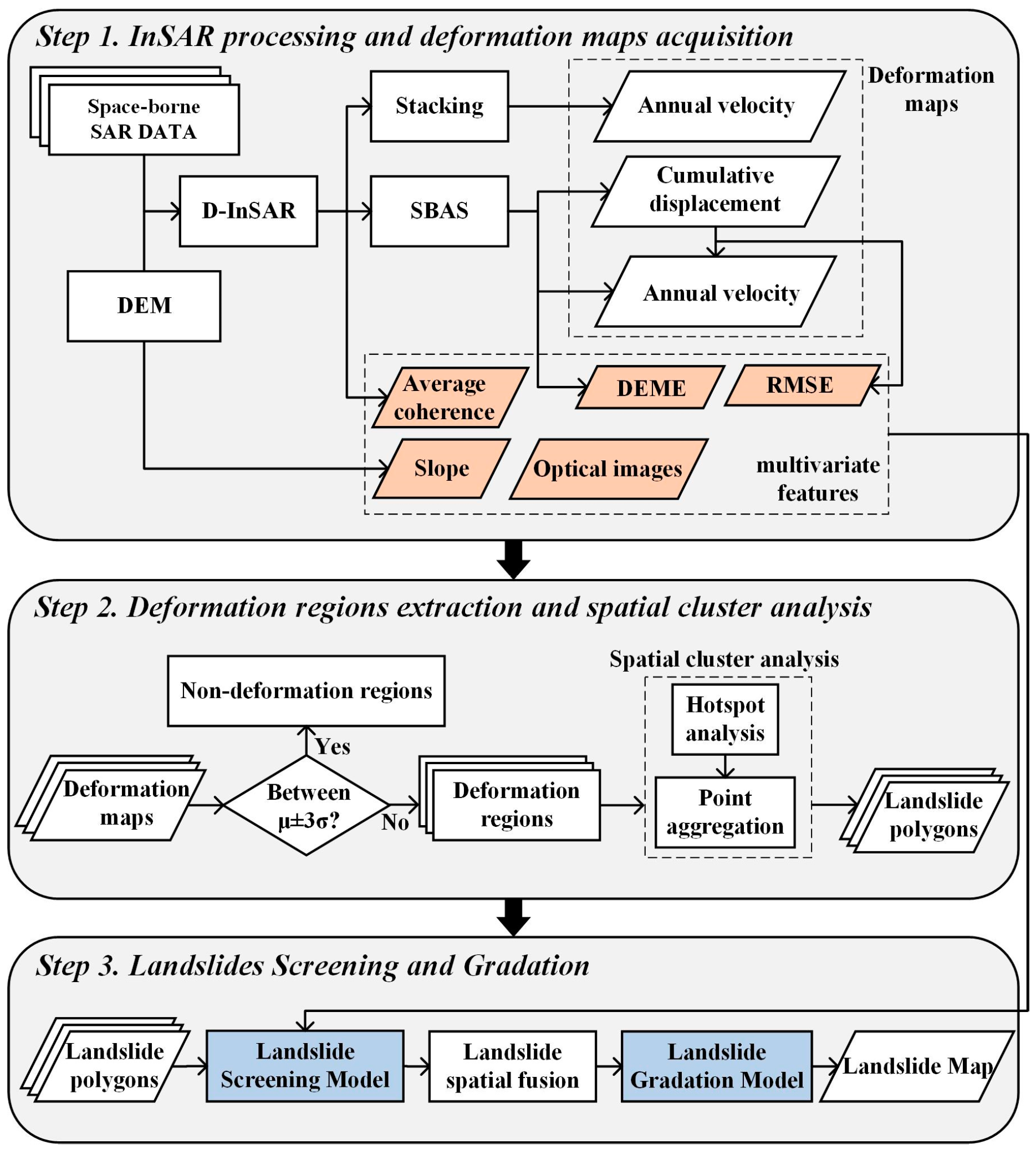
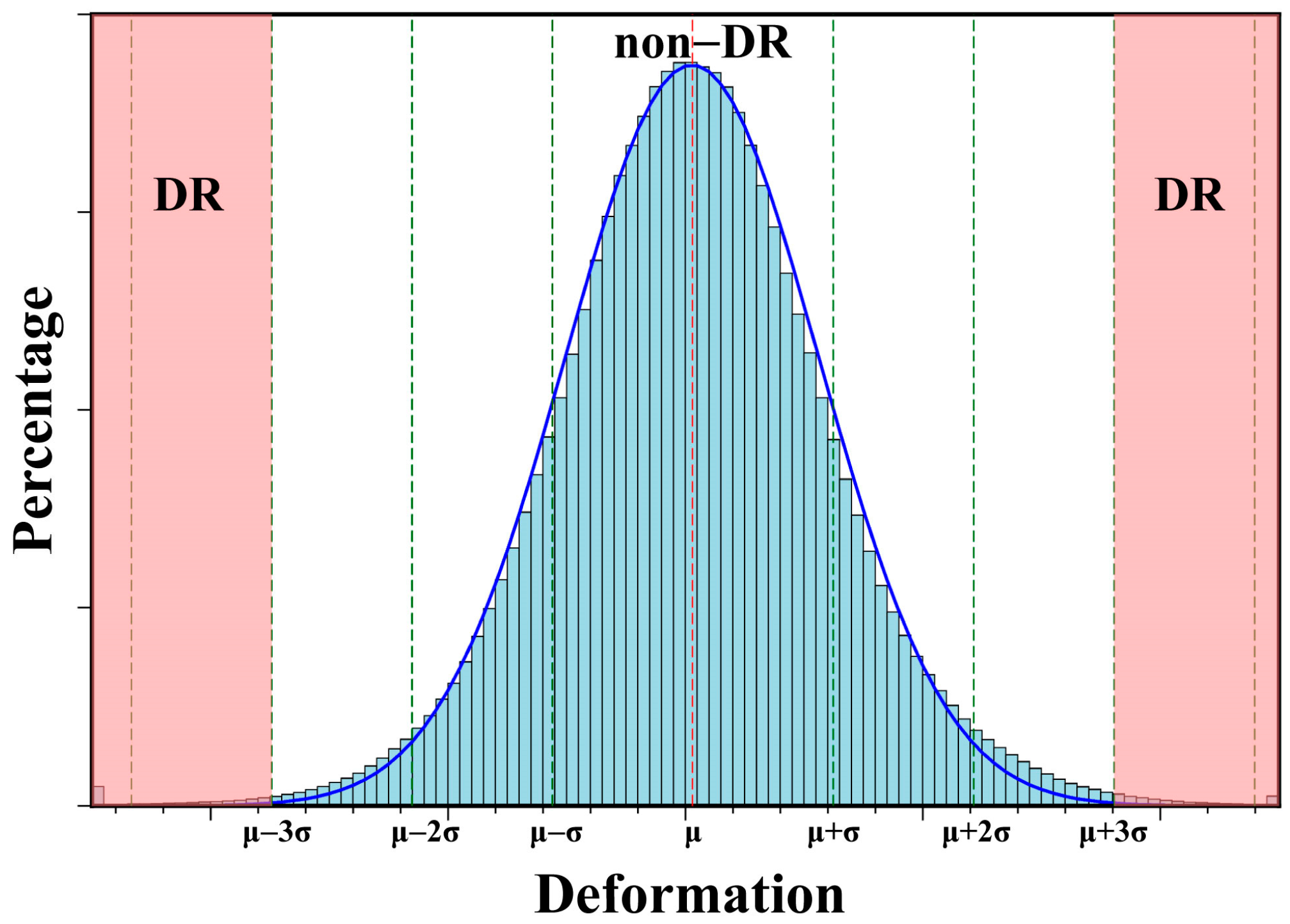
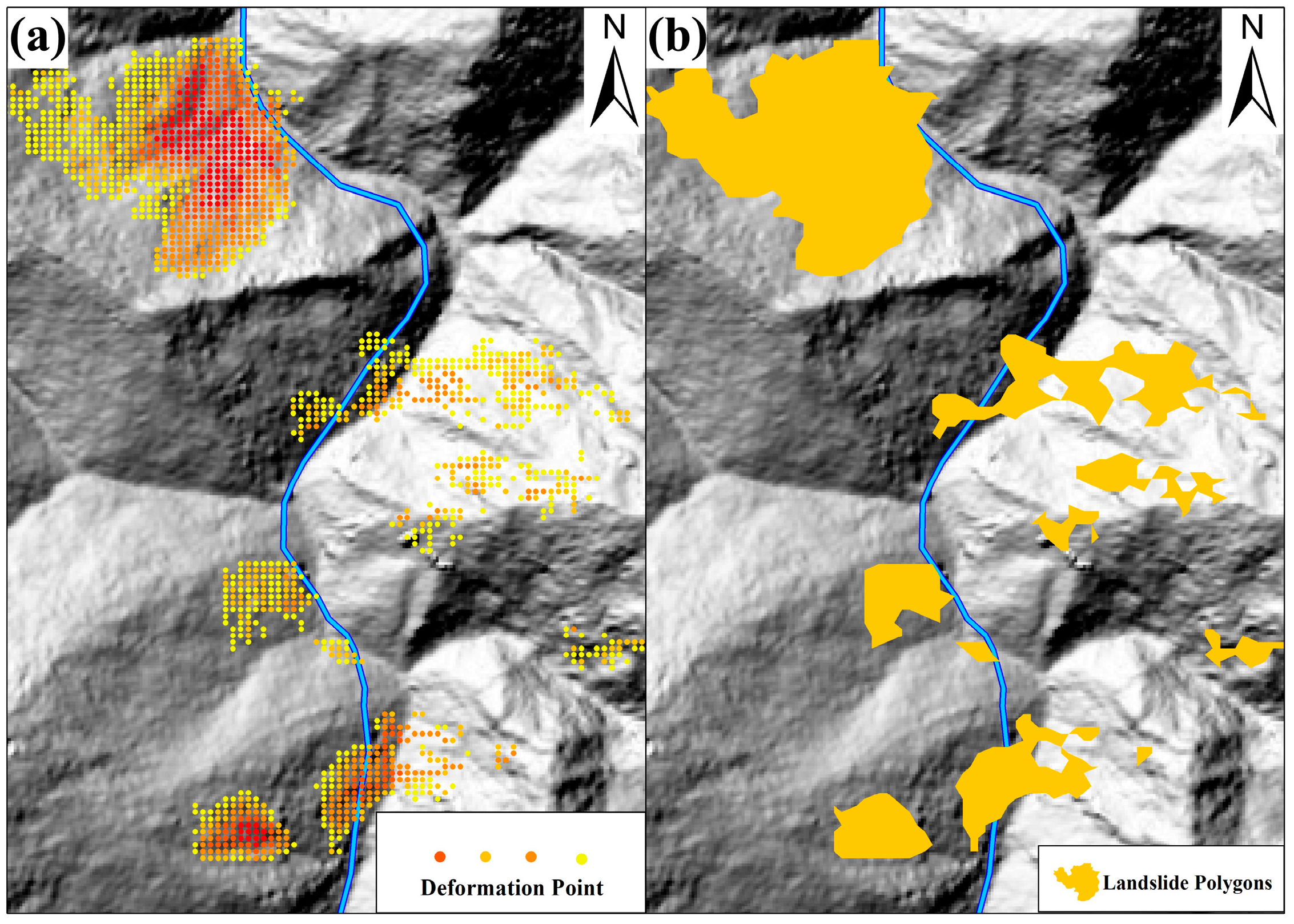





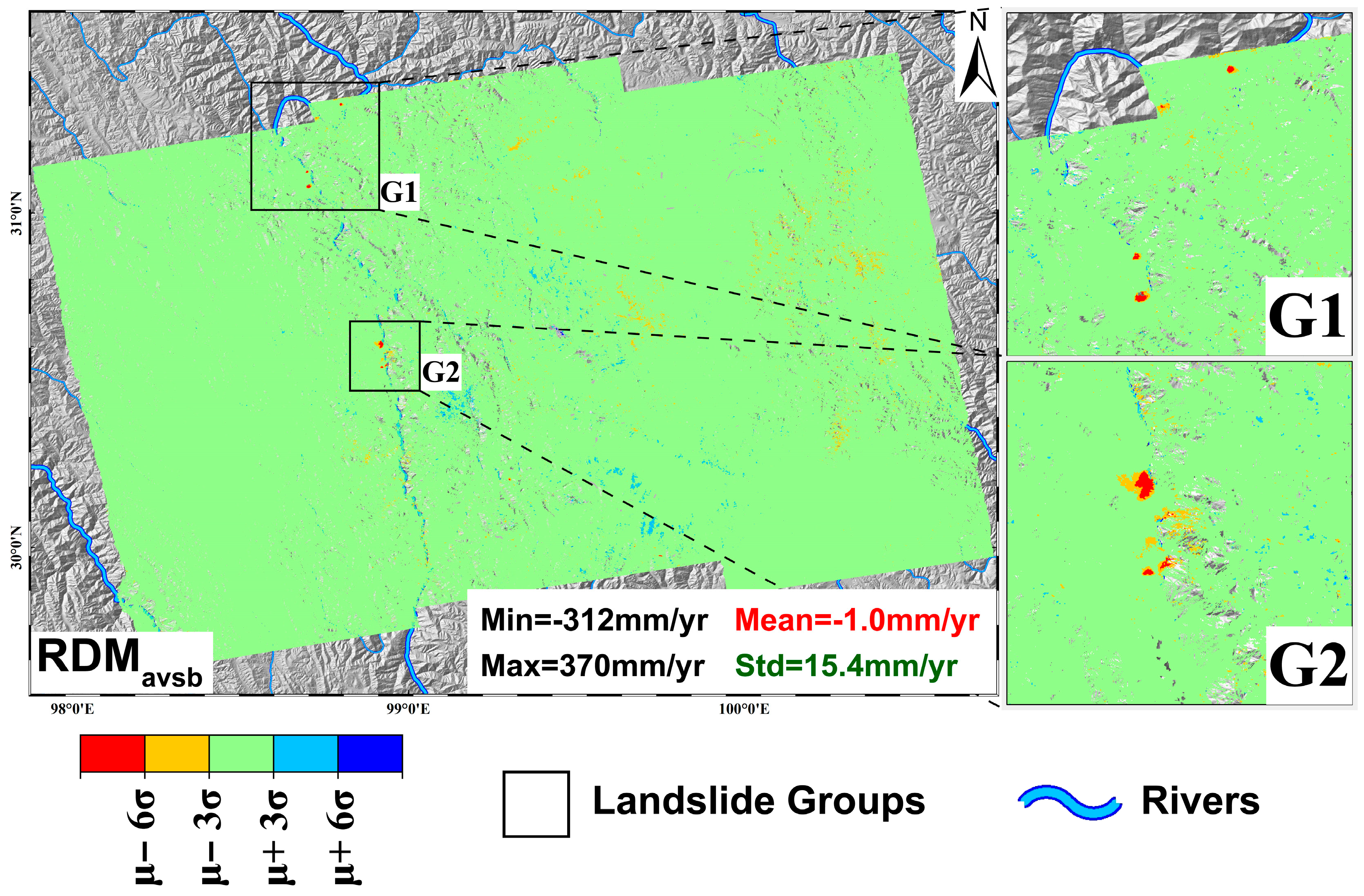
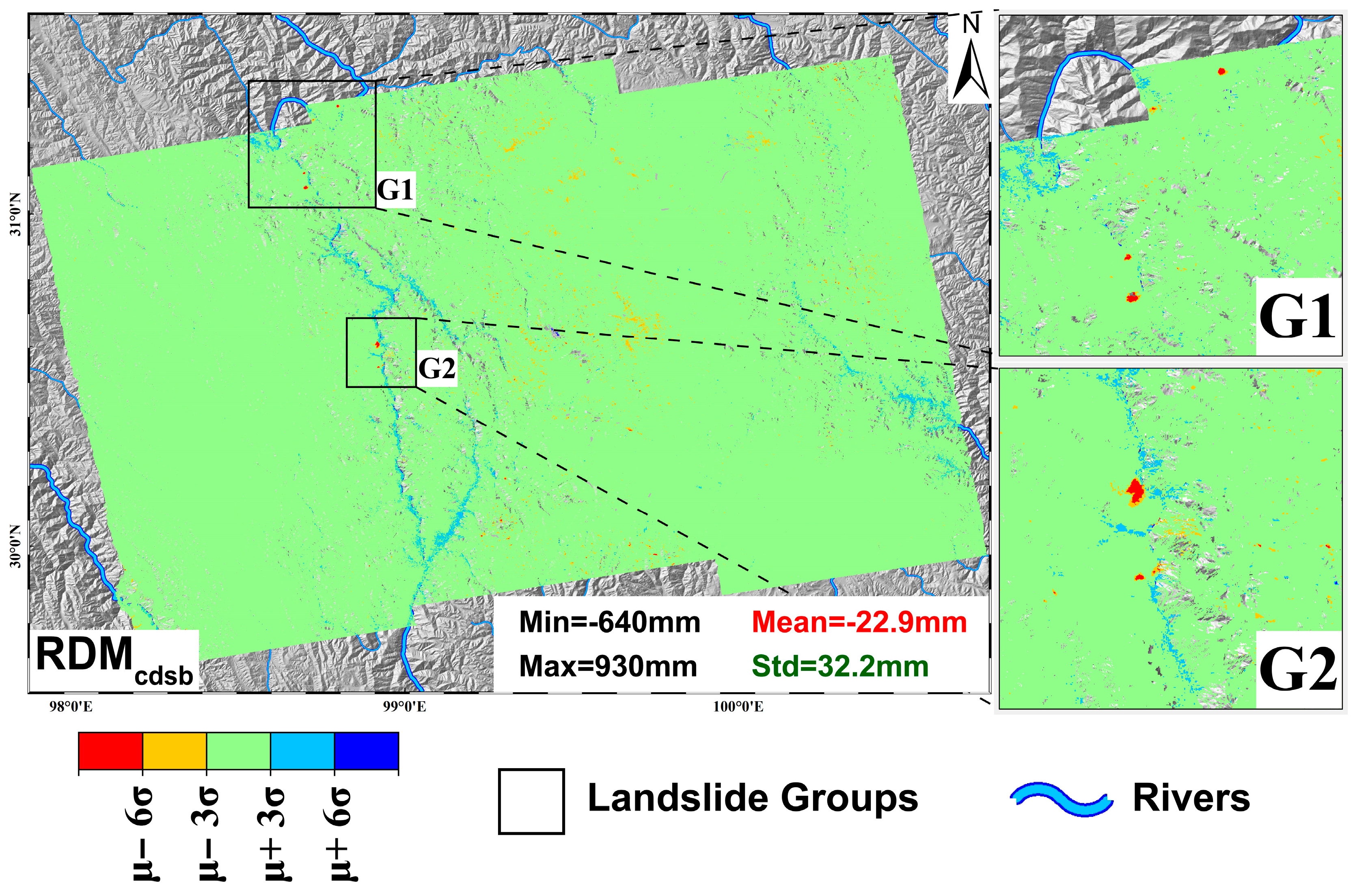
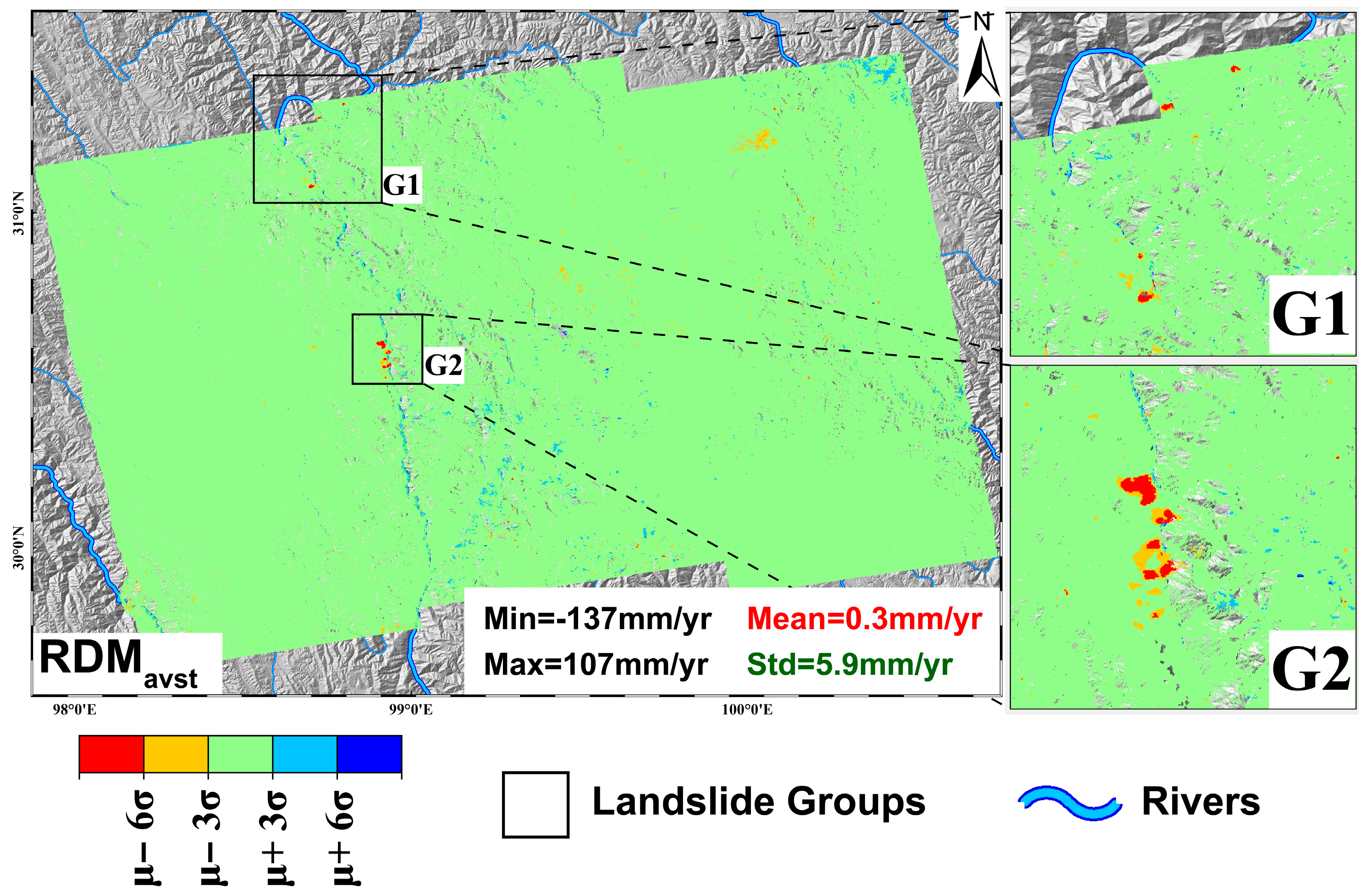
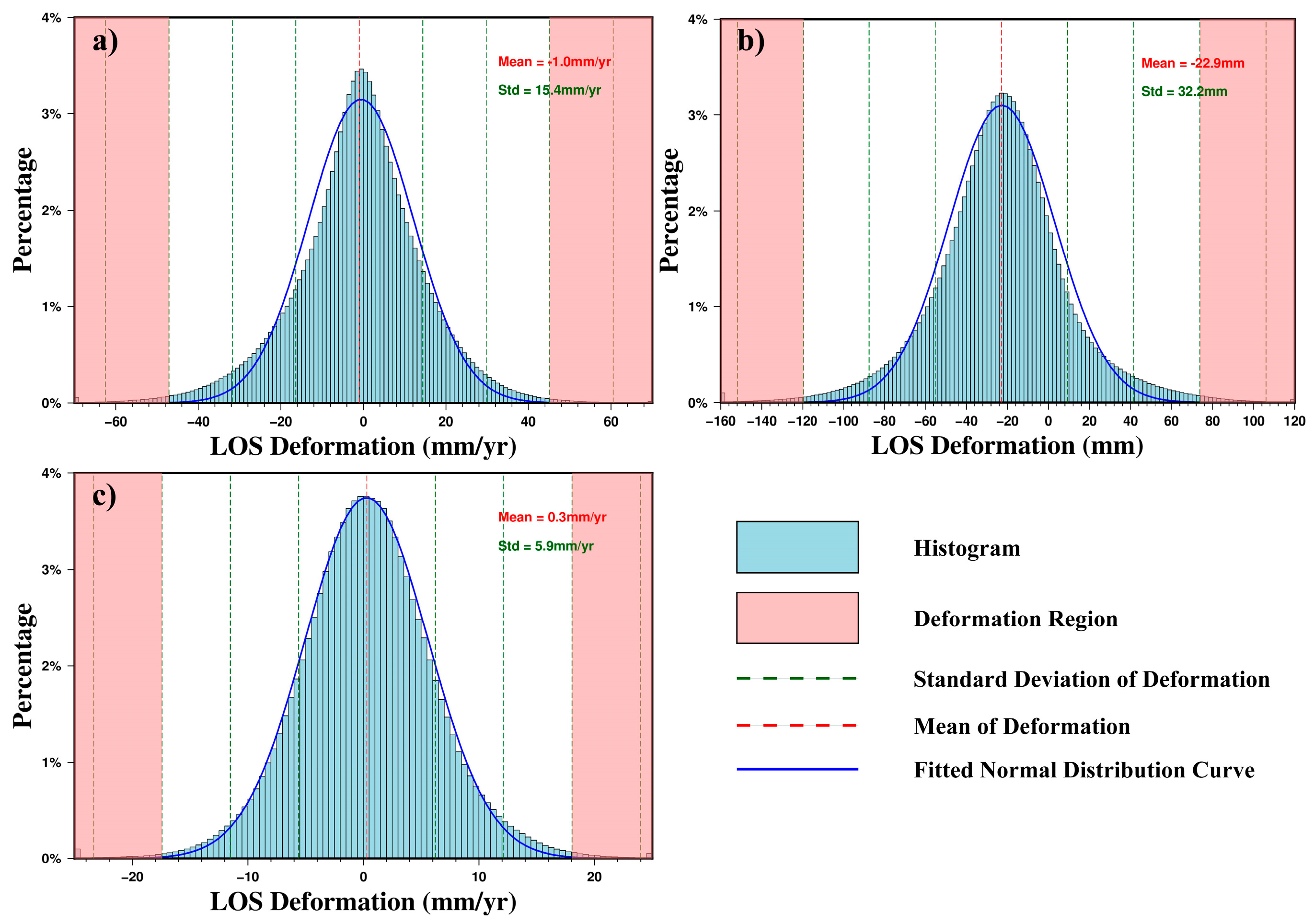
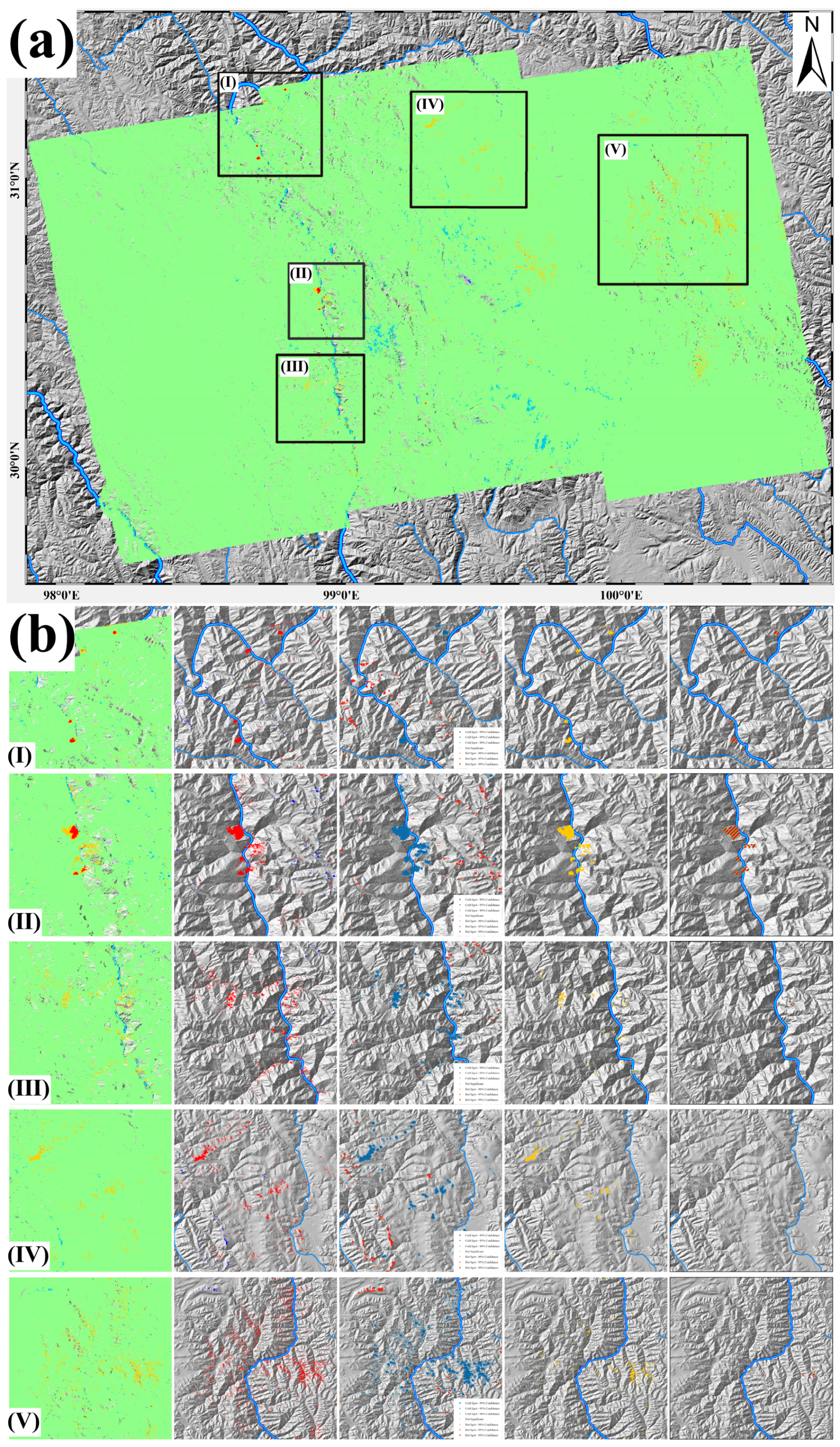
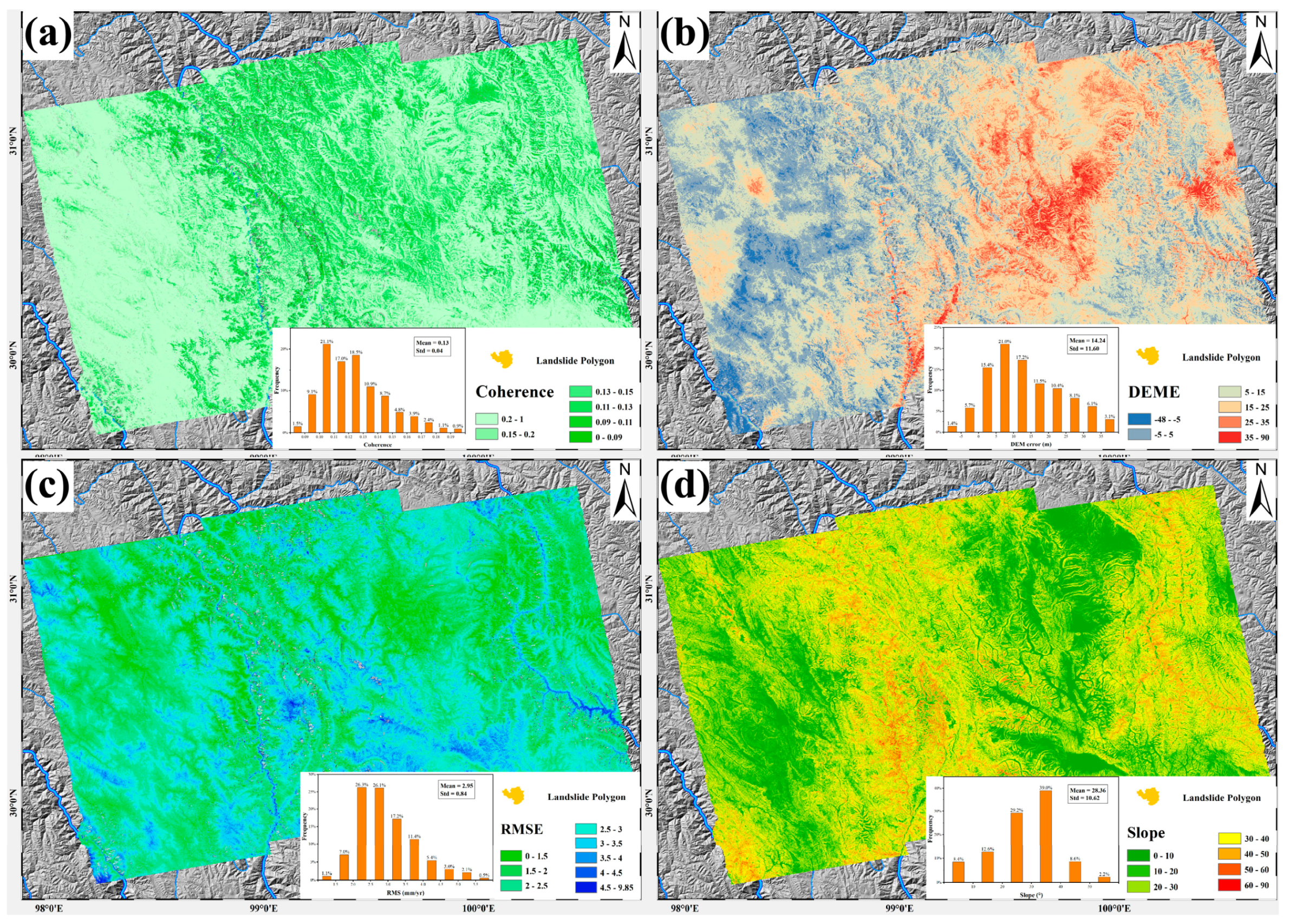
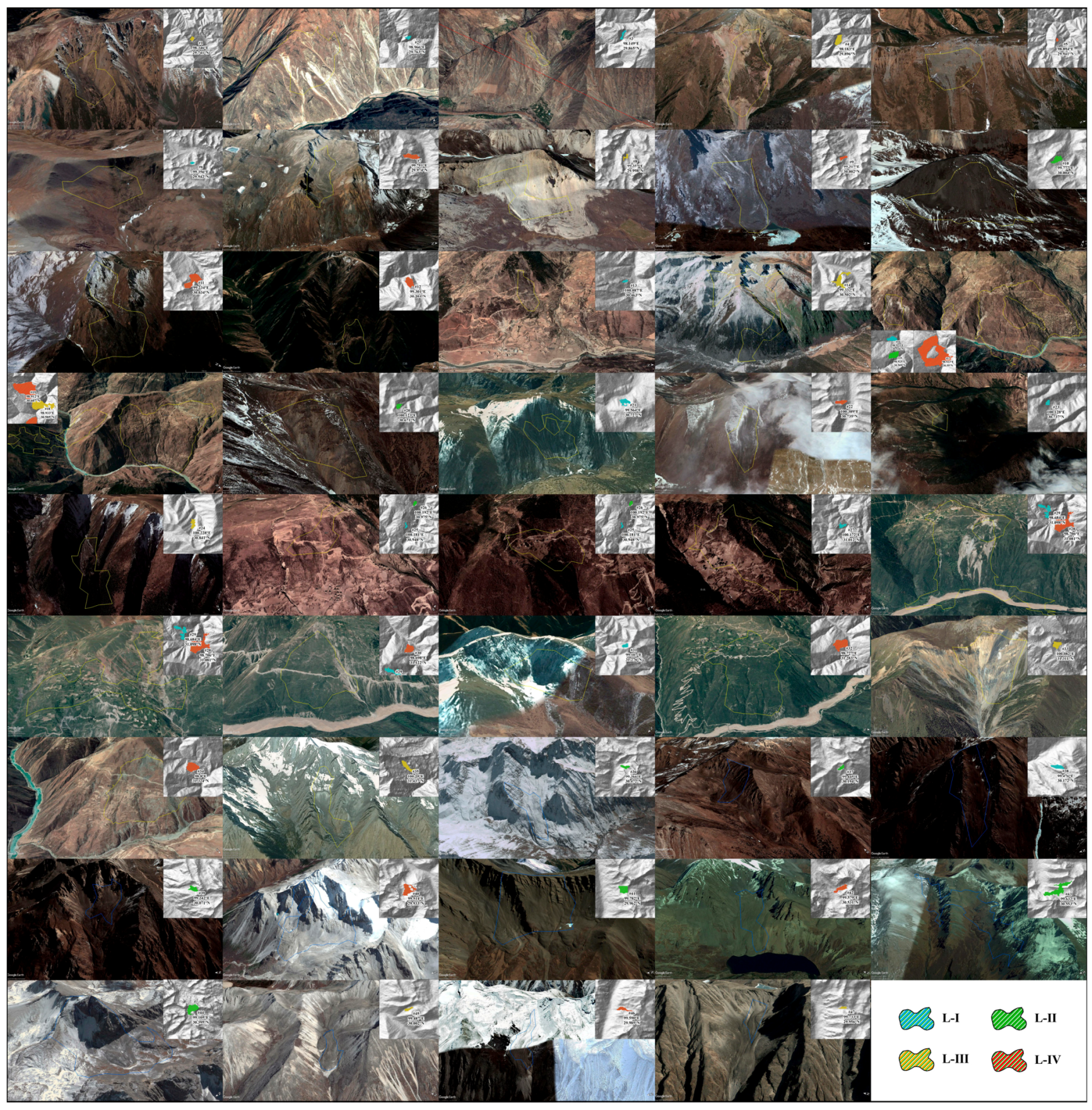

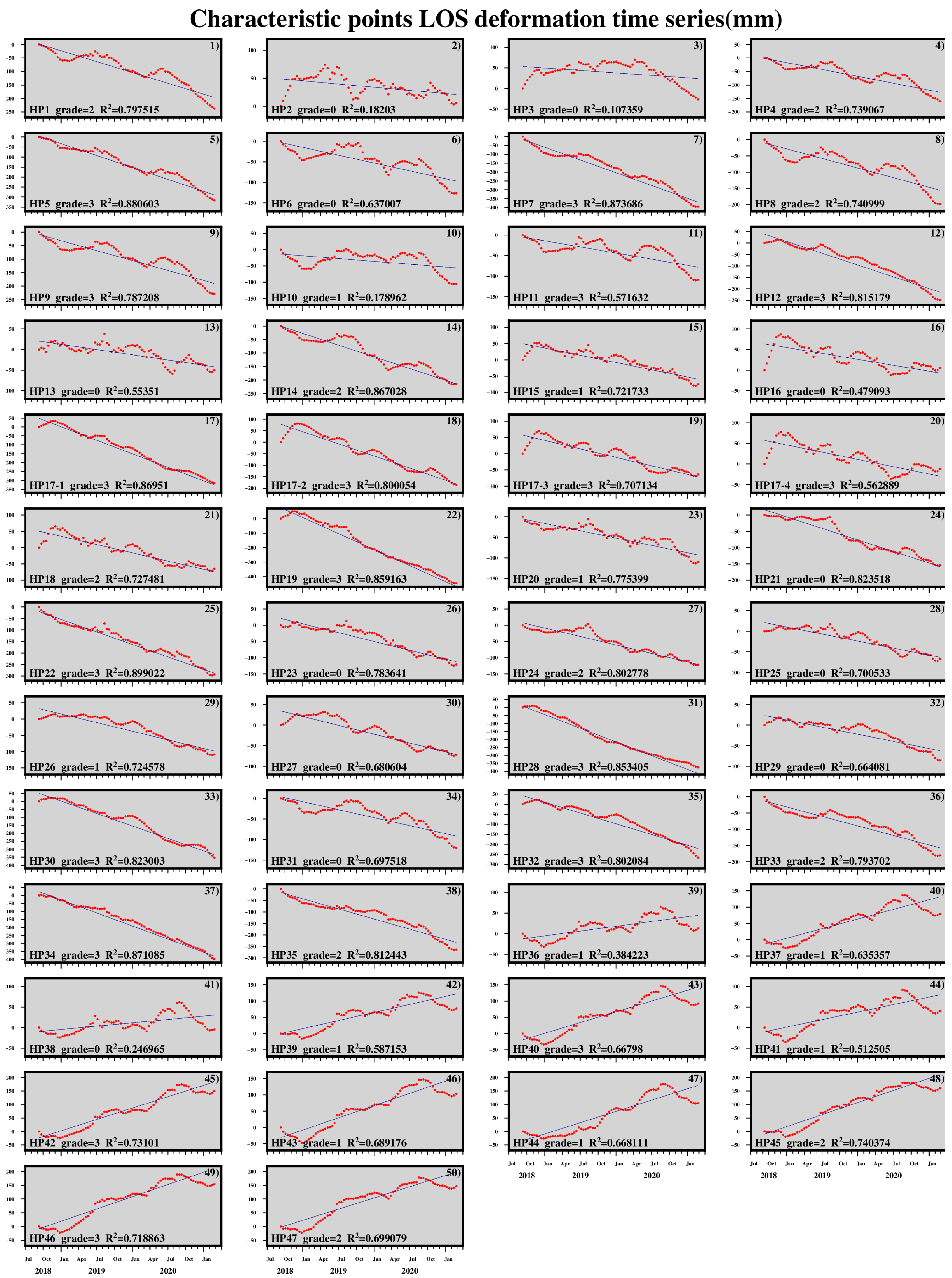
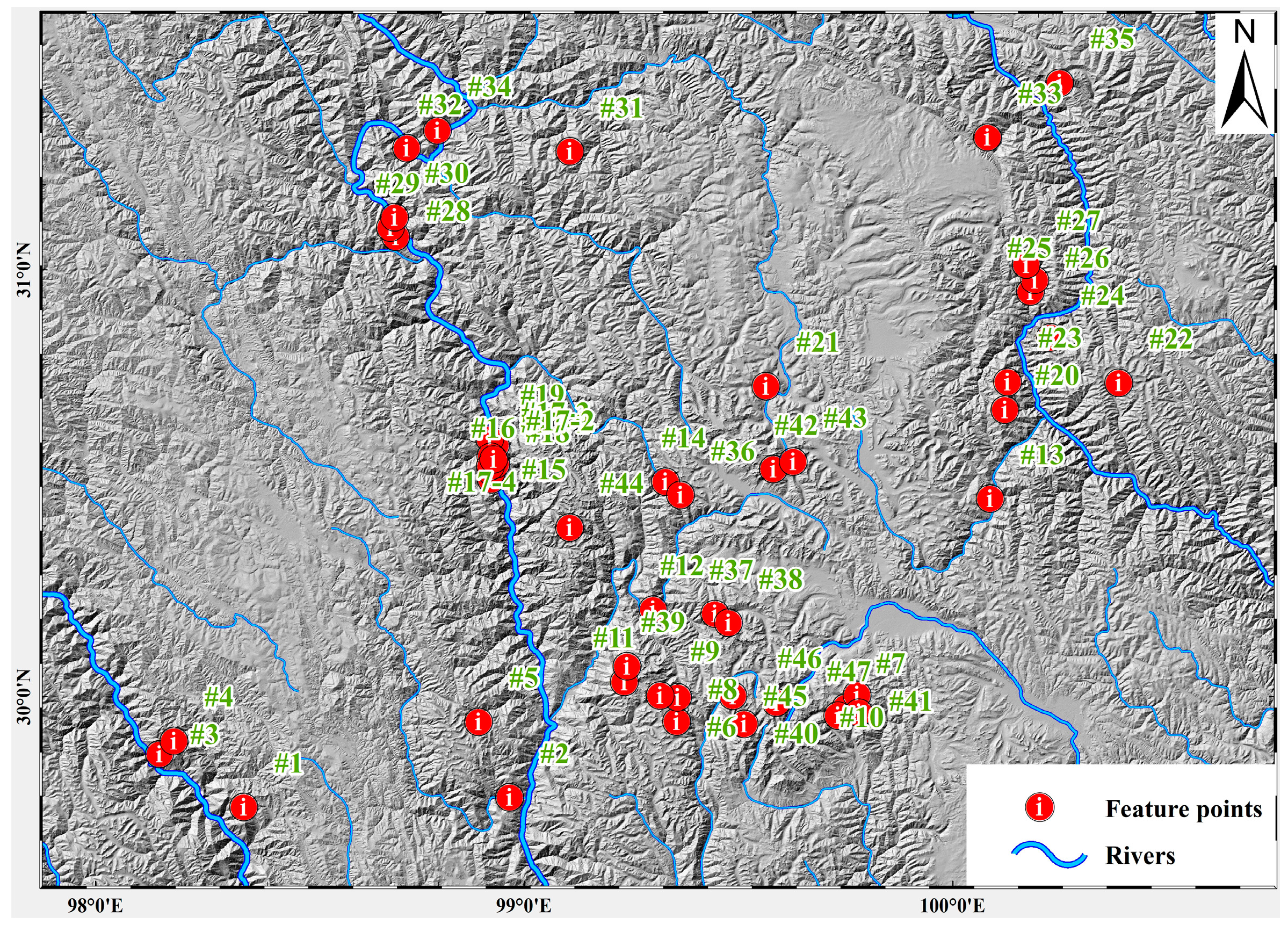
| Sensor | Sentinel-1 A |
|---|---|
| Orbit Direction | Ascending |
| Path Frame | 99–1280 |
| Acquisition Time | September 2018–February 2021 |
| Number of Images | 76 |
| Azimuth Angle | 247.3° |
| Incidence Angle | 34.34° |
| Ground Resolution | 5 m × 20 m |
| Multi-looked Ratio | 8:2 |
| Temporal Baseline | 25 day |
| Spatial Baseline | 100 m |
| Number of Interferograms | 130 |
| Features | Research Area | Average within Polygons | |||||||
|---|---|---|---|---|---|---|---|---|---|
| Min | Max | Mean | Std | Min | Max | Mean | Std | Threshold | |
| γmean | 0.07 | 0.97 | 0.23 | 0.12 | 0.08 | 0.4 | 0.13 | 0.04 | >0.13 |
| RMSE (mm/yr) | 0 | 9.85 | 2.4 | 0.64 | 1.35 | 6.69 | 2.95 | 0.84 | <2.95 |
| DEME (m) | −48.4 | 90.6 | 11.6 | 10.1 | −12.57 | 51.05 | 14.24 | 11.6 | −11.6~11.6 |
| Slope (°) | 0 | 83 | 24 | 12.1 | 2.38 | 58.74 | 28.36 | 10.62 | >25 |
| Area (km2) | - | - | - | - | 0.003 | 4.185 | 0.124 | 0.289 | >0.1 |
| Grade | Num | Percent | R2 | ||
|---|---|---|---|---|---|
| Min | Max | Mean | |||
| L-I | 12 | 25.53% | 0.11 | 0.82 | 0.55 |
| L-II | 10 | 21.28% | 0.18 | 0.78 | 0.59 |
| L-III | 10 | 21.28% | 0.70 | 0.87 | 0.77 |
| L-IV | 15 | 31.91% | 0.57 | 0.90 | 0.80 |
Publisher’s Note: MDPI stays neutral with regard to jurisdictional claims in published maps and institutional affiliations. |
© 2022 by the authors. Licensee MDPI, Basel, Switzerland. This article is an open access article distributed under the terms and conditions of the Creative Commons Attribution (CC BY) license (https://creativecommons.org/licenses/by/4.0/).
Share and Cite
Dai, H.; Zhang, H.; Dai, H.; Wang, C.; Tang, W.; Zou, L.; Tang, Y. Landslide Identification and Gradation Method Based on Statistical Analysis and Spatial Cluster Analysis. Remote Sens. 2022, 14, 4504. https://doi.org/10.3390/rs14184504
Dai H, Zhang H, Dai H, Wang C, Tang W, Zou L, Tang Y. Landslide Identification and Gradation Method Based on Statistical Analysis and Spatial Cluster Analysis. Remote Sensing. 2022; 14(18):4504. https://doi.org/10.3390/rs14184504
Chicago/Turabian StyleDai, Huayan, Hong Zhang, Huayang Dai, Chao Wang, Wei Tang, Lichuan Zou, and Yixian Tang. 2022. "Landslide Identification and Gradation Method Based on Statistical Analysis and Spatial Cluster Analysis" Remote Sensing 14, no. 18: 4504. https://doi.org/10.3390/rs14184504






